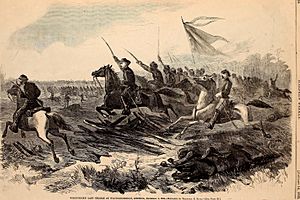Battle of Waynesboro, Georgia facts for kids
Quick facts for kids Battle of Waynesboro |
|||||||
|---|---|---|---|---|---|---|---|
| Part of the American Civil War | |||||||
|
|||||||
| Belligerents | |||||||
| Commanders and leaders | |||||||
| Judson Kilpatrick | Joseph Wheeler | ||||||
| Strength | |||||||
| 6,000 | 4,000 | ||||||
| Casualties and losses | |||||||
| 190 | 250 | ||||||
The Battle of Waynesboro was an important fight during the American Civil War. It took place on December 4, 1864, in eastern Georgia. This battle happened near the end of General William T. Sherman's famous "Sherman's March to the Sea". In this battle, Union cavalry troops, led by Brig. Gen. Judson Kilpatrick, defeated Confederate cavalry. The Confederate forces were led by Maj. Gen. Joseph Wheeler. This Union victory cleared the way for Sherman's armies to reach their main goal, the city of Savannah.
Contents
The March to Savannah
As General Sherman's main army marched southeast through Georgia, his cavalry, led by General Kilpatrick, rode ahead. Kilpatrick's job was to protect Sherman's main force. He also had to cause trouble for the Confederates.
Early Skirmishes
In late November 1864, Kilpatrick's troops reached a wooden railroad bridge north of Waynesboro, Georgia. They managed to burn part of it. However, Confederate troops, sent by General Wheeler, quickly drove them away.
After the Confederates left, Kilpatrick entered Waynesboro the next day. His troops destroyed a train and a lot of private property. But then, Wheeler's forces pushed them out of the town. Early on November 28, Wheeler surprised Kilpatrick's camp south of Waynesboro. He attacked and forced Kilpatrick's troops to retreat southwest.
The Main Battle
General Kilpatrick was tired of Wheeler's constant attacks. So, on the morning of December 4, he decided to attack Waynesboro with all his troops. His goal was to finally defeat Wheeler's smaller force.
Union Advance
Kilpatrick's cavalry was now supported by two groups of infantry (foot soldiers). These soldiers came from another Union division. They advanced from Thomas's Station, heading north. Their plan was to burn the bridges over Brier Creek, which were north and east of Waynesboro.
As they moved forward, Kilpatrick's troops found Wheeler's Confederates waiting for them. The Confederates had set up defenses across the road. The Union forces attacked, pushing back the Confederate skirmishers (soldiers who fight in small groups).
Overcoming Barricades
The Union troops then faced strong defensive lines made of barricades. It took them time and effort, but they eventually broke through these defenses. As the Union advance continued, they found even more barricades. These also took time to overcome.
After a tough fight, Wheeler's outnumbered forces retreated into Waynesboro. They quickly set up another line of barricades in the town's streets.
Confederate Counterattack and Retreat
Inside Waynesboro, General Wheeler ordered a charge. Troops from Texas and Tennessee bravely attacked the Union forces. Wheeler's goal was to gain time. He wanted his men to withdraw across Brier Creek. He also wanted to block the road to Augusta. At that time, it seemed like Augusta might be General Sherman's next target.
After fierce fighting, the Union troops broke through the Confederate lines. Wheeler's forces quickly pulled back.
Aftermath
Kilpatrick finally reached his goal at Brier Creek. He burned both the rail and wagon bridges there. Then, his troops withdrew. The supporting infantry brigades marched to Jacksonboro. They rejoined their main division. Kilpatrick's cavalry followed that evening.
The Battle of Waynesboro was a clear Union victory. It helped General Sherman's army continue its march. Over the next few days, more fighting occurred. This allowed Sherman to get closer to his final objective, Savannah.



